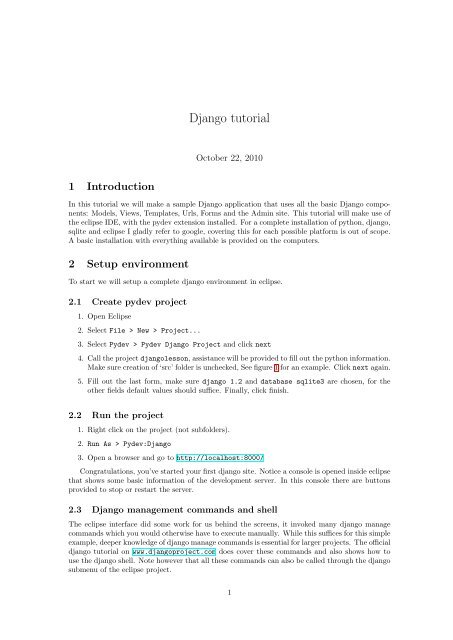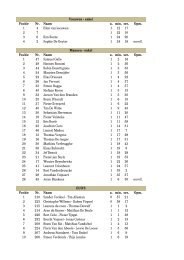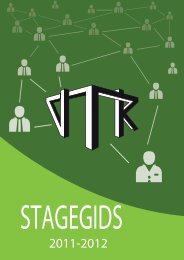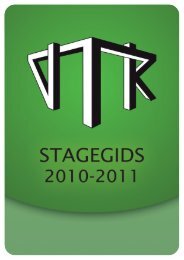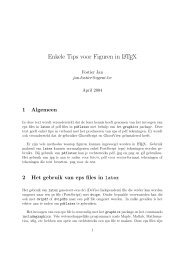Django tutorial - VTK
Django tutorial - VTK
Django tutorial - VTK
Create successful ePaper yourself
Turn your PDF publications into a flip-book with our unique Google optimized e-Paper software.
As you can see the code consists of standard html, with some template-specific commandsadded. In general you should know that {% command %} executes a specific command and {{ variable }}displays a variable. A full list of built-in template tags and variables can be found in the djangodocumentation 1 .In this example we use the for tag to loop over a list members which we received from theview, similar to a python for loop. Each item of this list will be a member object which we canhandle in almost exactly the same way as in normal python code. We display the list very similarto the original view.6.3 Using the template from a viewTo use templates in views, most often the method render_to_response is used, this is a djangofunction that does some complexer template processing behind the screens. It accepts 2 arguments,the template name and a python dictionary with the values it should pass. To use it, import it atthe top of views.py as follows:from django.shortcuts import render_to_responseThe second argument passed is a python dict, this is a structure that has a key value relationshipand is defined as follows:values = {"members": Member.objects.all()}In this simple example we define a dictionary values where we assign the key "members" tothe value Member.objects.all() (a list of all members). In normal python code we could justcall values["members"] to use it. Putting everything together we can change the view from theprevious section to this.def membersList(request):variables = {"members": Member.objects.all()}return render_to_response("members/list.html",variables)When you restart the django server and go to the url you specified for this view, you can nowsee it is rendering HTML by inspecting the source of the webpage (for firefox: press ctrl-u).7 FormsWhile you already have all the building blocks for a basic website, we will go deeper in one last veryuseful and very powerful system that django provides: forms. Forms help taking responsibilitiesaway from views, making the code lighter and easier to maintain and reuse. The main function ofa <strong>Django</strong> form is to validate input and decide which action to take with that input. An additionalfeature is that django forms allow to easily generate HTML forms. Sadly enough, many peopleuse forms only for this target, which results once again in long views to handle input processing.To keep things simple we will create a basic form that asks for someone’s full name, checks ifit is longer than 3 characters and displays it if it’s correct.7.1 Creating the formIn the members application, create a new module called forms.py. The form should look like this.from django import formsclass NameForm(forms.Form):name = forms.CharField()1 http://docs.djangoproject.com/en/dev/ref/templates/builtins/7
8 ConclusionAfter completing this <strong>tutorial</strong> you should be familiar with the way django powered websites work.To further practice your skills I have two suggestions (order does not matter)First, try to add an activity application to the djangolesson project where users can subscribethemselves too. This will help you understand the basics learned here even more and willrequire you too try some new things which you can’t simply type over. As a hint, you’ll probablyneed 2 models (Activity and Subscription). To create a subscription form, search for ModelFormin the django documentation, it will show you how you can easily generate django forms frommodels.Second, follow the django <strong>tutorial</strong> on the official website www.djangoproject.com. While thereis much overlap, the official <strong>tutorial</strong> is longer and goes into more detail about some aspects, it willgive you more insight in how everything works.After this, go experimenting, try to build your own simple site or join a team working on one.One clue: always keep the official django documentation and google close. When you encounter aproblem that you think will take you many hours of coding, the odds are high it’s already providedin django itself or by an external django application.9


